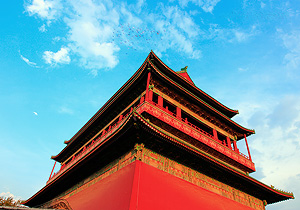Bell Tower and Drum Tower

In ancient China, bell and drum towers were originally used to tell the time and give people a means of organising their days. Most towns and cities contained them, the biggest and tallest being the towers built in Beijing. Built in 1272 during the reign of Kublai Khan of the Yuan Dynasty (1206 - 1370), they have a traditional Chinese imperial design and stand on a north south axis creating a square between them. They were used up until 1924, when the last emperor Pu Yi was evicted and the modern system of timekeeping was installed by the new government.
The Drum Tower (Gulou) was originally called the Tower of Orderly Administration and was rebuilt in 1480 east of the original site by the Ming Emperor Yongle. In 1800 it was renovated by Emperor Jiaqing of the Qing Dynasty (1644 - 1912). Standing 46.7 meters high on a 55 meter long, 30 meter wide terrace, the Drum Tower originally housed 24 drums. The drums were used to keep the time at night starting at 7p.m. with 18 quick and 18 slow beats. Every two hours after, the time was marked with another single beat until 7a.m.
At one time four bronze clepsydras were used in the tower. Connected to a bronze gong, they rang the time every 15 minutes until they were replaced by a timing system using burning incense coils. Presently, the tower houses the People's Cultural Hall of the East City District.
The Bell Tower (Zhonglou) is one hundred meters south of the Drum Tower was rebuilt during the Qing Dynasty after being destroyed by fire. Hanging on the second floor is the largest bell in a China. A sixty three ton, seven meter tall cast bronze bell that can reportedly be heard 20 kilometers away. Legend says the daughter of the bells caster, sacrificed herself in the molten bronze so the gods would ensure a perfect casting.
On New Year's Eve 1990, the bell was rang again and the drums on New Year's Eve 2001 after being silent for so long. Since then, the drum and bell sound every New Years Eve 108 times.